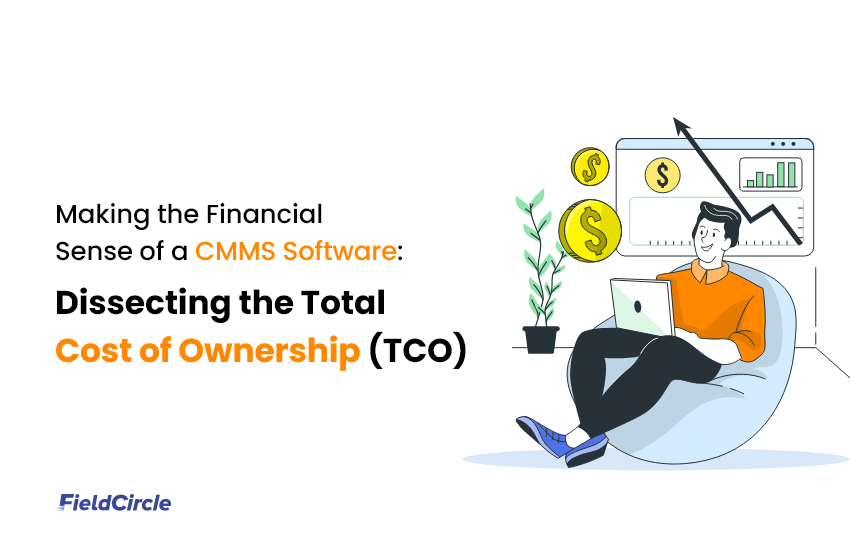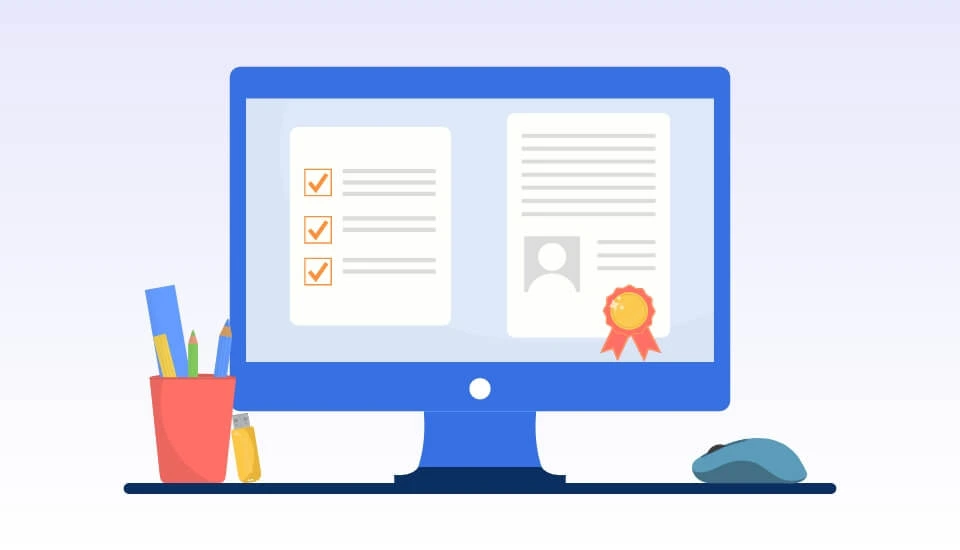Making the Financial Sense of a CMMS Software: Dissecting the Total Cost of Ownership (TCO)

What did you do when you brought a change to your existing maintenance process? Along with planning, budgeting was the activity that rivetted your focus.
And why not? Finally, everything boils down to cost – whether it is initiating a new activity or bringing a change to the existing process.
You calculate the total cost of an asset before you start using it and so too applies to a computerized maintenance management system (CMMS), which has asserted its importance in most industries.
The question emerges: How to calculate the TCO? Or in other terms How much would it cost us to implement and sustain a maintenance management application?
It is here that a comprehensive understanding of the total cost of ownership (TCO) of a CMMS solution becomes a focal point.
TCO carries significance throughout the software’s entire lifecycle. As a result, a strategic approach to it drives cost-based decisions. PFMA states that a CMMS can reduce maintenance costs, helping organizations save between 10 and 15% annually, but due to the cost of the maintenance management applications, many maintenance managers and organizations are reluctant to implement one. With a comprehensive TCO analysis, enterprises can overcome this doubt and successfully reap benefits from a maintenance application.
We look at each element that makes TCO, so that you get a fair idea of the elements that add to it, and accommodate them in your budgetary framework.
Why is it important to consider the Total Cost of Ownership (TCO) of a CMMS?
Total Cost of Ownership (TCO) is a critical metric for evaluating the comprehensive financial impact of implementing and maintaining a Computerized Maintenance Management System. It goes beyond the initial acquisition cost, considering the entire lifecycle expenses associated with the application.
With TCO calculation at your disposal, you get a realistic and holistic view of the investment required over time, helping to avoid budget overruns and unforeseen expenses. By considering the complete cost spectrum, decision-makers can make informed choices regarding the implementation, balancing upfront expenses with long-term benefits.
When you calculate TCO, it also aids in comparing different options. You can identify solutions that fit with your budget and are in line with overall financial objectives.
One ignored area where TCO helps is that it makes all stakeholders aware of the full financial implications of adopting an application. It thus offers a comprehensive understanding of the system’s value and impact on the organization’s bottom line.
Overall, understanding TCO is pivotal for making financially prudent decisions and maximizing the return on investment through the implementation of maintenance management software. By evaluating the CMMS software cost as part of the total cost of ownership, businesses can gain a clearer picture of long-term expenses and value, ensuring they invest in a solution that aligns with both their budget and operational goals.
Breaking the CMMS Total Cost of Ownership (TCO)
Calculating total cost of ownership (TCO) entails considering all those elements that go into making it. Below, you’re getting the most accurate idea of it as we look at all cost elements across multiple areas that the TCO of a maintenance application comprises.
Initial Costs
- Software License Fees: These pertain to the initial purchase price or licensing costs of the maintenance application. They represent the foundational investment required to gain access to the software and its features and will be structured based on the size of your maintenance team (Number of users).
- Implementation Costs: These costs pertain to the deployment of the software, including costs around installation necessary to integrate the software into your existing infrastructure. They will typically include the cost of integrating the software with the existing infrastructure, expenses for integrating the tool with third-party software applications, such as ERP systems, etc., and costs associated with testing the implementation of the application.
- Customization and Configuration: Some costs are incurred for aligning the implemented CMMS software to an enterprise’s unique requirements. For instance, you might be a medical equipment manufacturer or business looking to optimize maintenance operations in its facility management function, where the application has to have workflows that are customized to match niche contexts. The adjustments and modifications made to the software’s features, workflows, and functionalities will incur these expenses.
Infrastructure Costs
- Hardware: The procurement and maintenance of servers, computers, and other physical equipment necessary to host and run the software result in these costs. It will also include the costs associated with implementing barcode or RFID technology for asset tracking and inventory management within the. Further, the costs associated with sensors for condition-based monitoring of equipment will also add to the Hardware costs.
- Networking: They cover the cost of routers, switches, and any other piece of equipment in the networking process, as well as ongoing expenses for maintaining sufficient bandwidth to support the system’s data exchange needs.
- Mobile Device: Yes, some cost will also be incurred by smartphones, tablets, or other mobile devices used by maintenance personnel to access and interact with the tool while in the field.
Operating Costs
- Software Maintenance Fees: These fees cover essential services provided by the vendor, such as software updates, patches, and technical support. You will incur them as ongoing operational expenses for having an up-to-date maintenance management system.
- User Training: Educating users prior they start beginning the use of the application or when some new functionality is introduced will bring some costs. Typically, the expenses will revolve around training programs, materials, and possibly external trainers or consultants.
- Support and Helpdesk: Just as there are costs of repairs for equipment, there are costs associated with support activities. These are the expenses for maintaining a support team and help desk infrastructure to address user queries, troubleshoot issues, and provide technical assistance related to the application.
Data Costs
- Data Storage Costs: The tool aids in making data-driven decisions creating cost elements around data. The data storage component includes the costs associated with acquiring, managing, and maintaining the infrastructure required for adequate data storage. It encompasses considerations such as server space, the associated hardware, and subscription fees.
- Data Migration: Expenses are incurred for transferring the existing maintenance data to the maintenance application. The process of extraction, transformation, and loading of data into the new system contributes to this cost.
- Data Conversion: The process transforms data from different file types, databases, or structures into a standardized format that aligns with the requirements. The expenses pertain to converting data into a format compatible with the software.
Security Costs
- Security Software: The inclusion of Security Software costs reflects the expenses associated with implementing additional security measures to safeguard maintenance data and uphold the integrity of the application. You must consider investments in antivirus programs, firewalls, intrusion detection systems, or other tools aimed at fortifying the overall security posture of the application.
- Data Security Measures: Encryption, access controls, regular security audits, and other measures to safeguard data integrity and confidentiality don’t come without any costs. These steps are essential to protect valuable maintenance data from potential breaches and ensure compliance with data protection standards.
Miscellaneous Costs
- Contingency: You will allocate a contingency fund for unprecedented issues such as software glitches, data migration issues, or additional customization requirements resulting in expenses.
- User Addition: As organizations grow or as the need for different user roles and permissions arises, additional user licenses may be required. You may have to expand the access of the maintenance software to new users. These costs cover the acquisition of new licenses, training for new users, and potential customization to accommodate diverse user needs.
- Energy Consumption Monitoring: These expenses are related to incorporating features within the software for monitoring energy usage and sustainability metrics. While initially an additional cost, energy monitoring features contribute to long-term cost savings and environmental responsibility.
- Downtime: In unprecedented situations, the software may experience disruptions or outages and halt the maintenance operations, impacting your maintenance program and thus resulting in loss of productivity. Processes such as asset management and work order management may be affected. This loss will make you incur some intangible costs; though a good provider will ensure that no disruption occurs in the functioning of the tool.
- Cloud Hosting Fees: For a cloud-based CMMS, you will incur cloud costs. These fees cover server usage, data storage, and maintenance. You must budget these recurring fees to sustain uninterrupted access.
- Compliance and Regulatory Costs: Ongoing efforts to update the system in response to changing regulations, conduct audits, and implement necessary features to meet compliance requirements come with some costs. You must allocate funds to manage compliance and regulatory processes to maintain the integrity of the tool and safeguard the organization against legal and regulatory risks.
Optimize your TCO with FieldCircle
The Total Cost of Ownership (TCO) of your maintenance application extends beyond some commonly perceived cost elements, as we saw. A maintenance application should improve your ROI, so look at it as a proactive tool that is potentially helpful for predictive and preventive maintenance, optimizing operations for cost-effectiveness and efficiency. When evaluating CMMS ROI, it’s important to factor in not just the upfront and recurring costs, but also the long-term gains in productivity, asset longevity, and reduced downtime that a robust maintenance system can deliver.
This is what FieldCircle CMMS does!
Our solution can be a key asset in maximizing ROI through your maintenance operations. The cost-effective nature coupled with robust functionalities makes it a win-win for both our clients and us.


